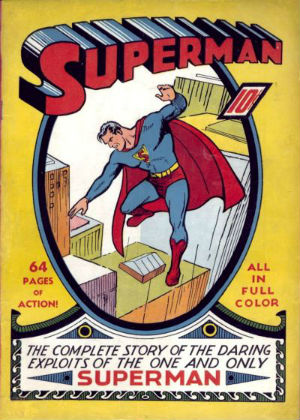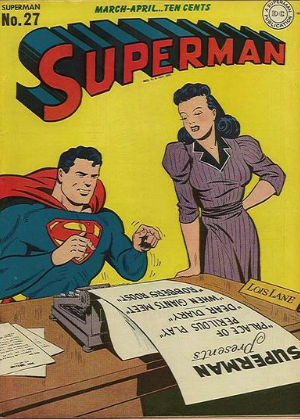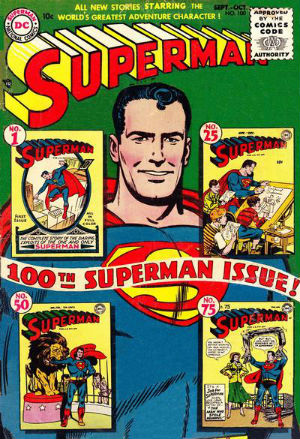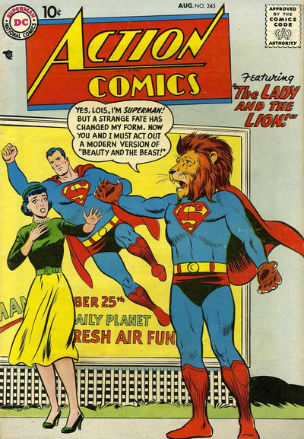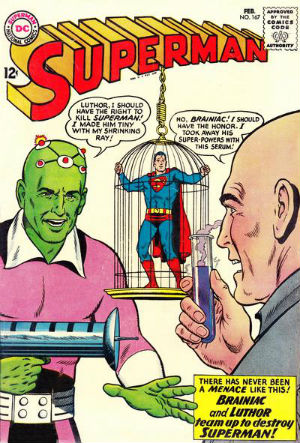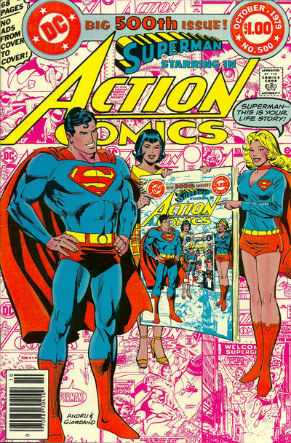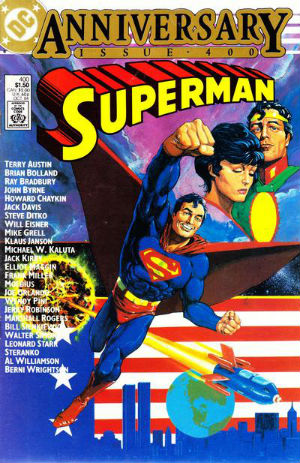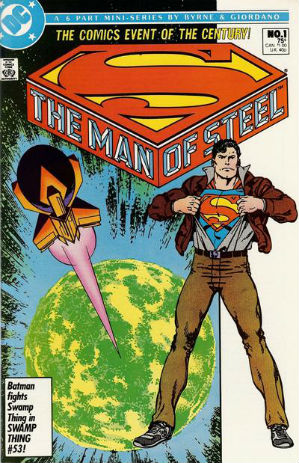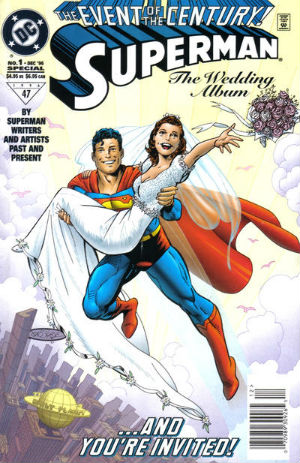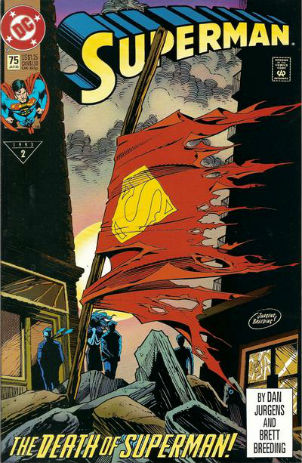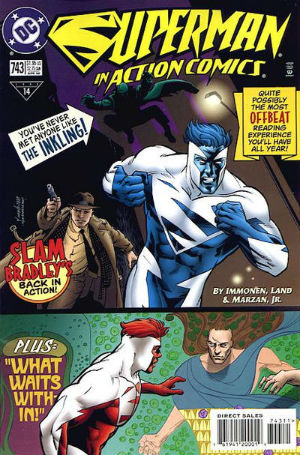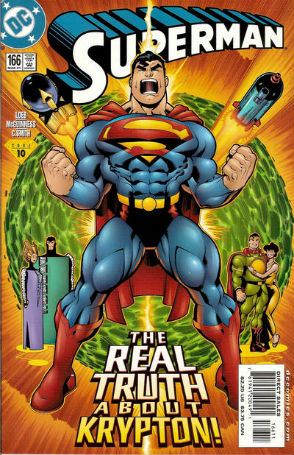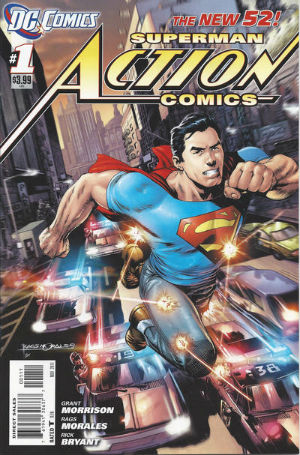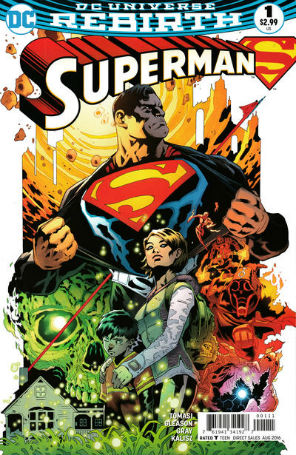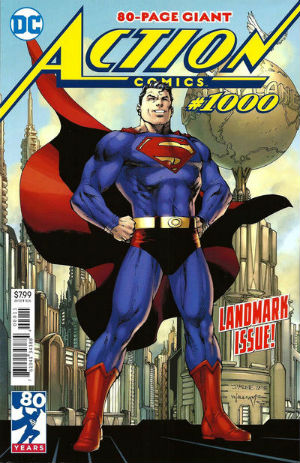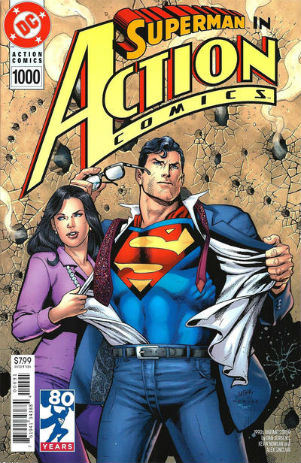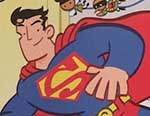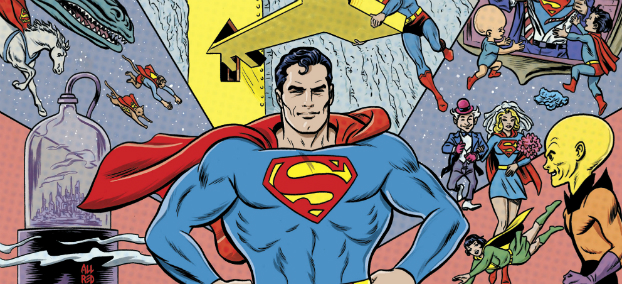
Catapulted away from his dying home planet. Hailed as the savior of his new world. Bearer of a red cape everyone instantly recognizes. And forever fighting for ‘Truth, Justic and the American Way.’ Superman’s 80 years old in 2018, Action Comics has hit a thousand issues. And now, with the arrival of Brian Michael Bendis, the Man of Steel seems bound for a resurgence in comics.
But what makes Superman such an omnipresent cultural icon? And what is his place today in a society that may be changing at the well-known pace of faster than a speeding bullet? Broken Frontier asked MCPHS University professor and comics scholar A. David Lewis to provide some insights into Superman’s longevity and his relevance in a world that’s radically different from the one in which he debuted in 1938.
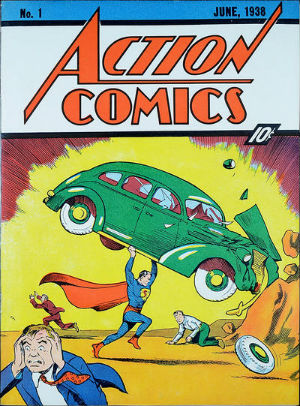 BROKEN FRONTIER: A lot’s been said about the ways in which our current global political climate compares to that of the 1930s, the era in which Superman was created. Is there any truth to that in the way the audience responds to Superman today?
BROKEN FRONTIER: A lot’s been said about the ways in which our current global political climate compares to that of the 1930s, the era in which Superman was created. Is there any truth to that in the way the audience responds to Superman today?
A. DAVID LEWIS: There is some truth to that, yes, but I think, in this context, Superman serves better as an example or model than a utility. That is, today’s global climate is eerily like that of the 1930s and late 1920s, and Superman was one of the popular responses to that environment. However, I don’t think he’s going to be the answer today, however similar it might be. He is already too much a part of the system, too tightly associated with Americanism and our place in the 20th century. We will need something more surprising, more native to the 21st century, to strike at our current crisis. If it’s to come from a superhero, then I’d look to the effects of the Black Panther film to serve this purpose rather than Superman in comics, on television, or in the Justice League.
How culturally relevant is Superman in 2018?
I made him sound quite old and outdated just then, didn’t I? No, Superman, I’d argue, remains immensely relevant in 2018 American culture, however not in the most direct manner. That is, it’s the problem of the character, the conflicts and paradoxes he represents, that keep him in our everyday popular consciousness. With each generation, we have to keep figuring out how Superman continues to fit our culture. The option to discard him just doesn’t seem to be there (nor am I arguing that it should).
As I just suggested, the character became some part of our national identity, and we’d rather not contemplate that the U.S.A. today is entirely unlike that of our Greatest Generation or American Century. Therefore, whether or not we fully utilize Superman is secondary to how we must make space for him. And, in the severely divided country we experience today, the shape of that space is tremendously difficult to circumscribe – thereby making it all the more important, while volatile.
In just 2010, Superman voiced the idea of renouncing his citizenship, and there was immediate, impassioned response against such an idea. This was in the Obama era, of course, and during the rise of the Teaparty in our politics, and it struck a nerve. I feel the reaction would be even stronger today were his current writers to place him in an explicitly political context.
Also, there’s his ubiquity – I can buy Superman car decals, toothpaste, denim pants, iPhone cases, bed sheets, and all manner of children’s items – and his simplicity: here’s a near-omnipotent man who wants to keep everybody safe. Throw a towel, preferably red, around one’s shoulders and any child can imagine being him, not to mention any adult can invoke him. That’s more convenient and empowering than a Lone Ranger mask, a Daniel Boone fur cap, or a pair of Lara Croft guns.
Is Superman a big reason for the recent success of DC Comics? Or are there other factors at play in why both readers and creators seem to be favoring DC over Marvel these days?
In terms of print comics, DC does seem to have the upper hand over Marvel as well as the larger market share these days, but that can very, very easily change. Readers and trends in the superhero genre, in particular, are quite mercurial; moreover, the audience itself is fragmenting. The space between new, young readers raised in an age of digital technology and post-9/11 sentiments and aging fanboys steeped in ‘70s or even ‘60s nostalgia grows ever wider.
Admittedly, DC has done some work to move Superman out of a classic (read: old) frame and into the present: hiring younger actors to portray him on screen, allowing Grant Morrison to write his initial years for the New 52 line, and launching Superman: Earth One books. But they’ve also backslid with the character, installing an older, fatherly Superman in place of the New 52 model and, most recently, playing up his long legacy with the publication of Action Comics #1000. (Marvel couldn’t resist either, returning to titles’ original numbering with their “Marvel Legacy” branding…which they are already abandoning.)
Basically, any part that Superman has in DC’s current success is in their underplaying of the character. Batman, incidentally, has been the center-stage focus for their latest Metal crossover series and much of the Doomsday Clock title thus far. I read DC as hesitant to deploy Superman, and that may be wise on their part.
Superman recently made mainstream headlines because of the return of his classic trunks, which were removed as part of The New 52 in 2011. Can you discuss how in terms of cultural resonance, this news was different from the Death of Superman, the marriage or even the Red/Blue stories where his regular powers were gone?
It’s funny how one sartorial choice gets such attention, isn’t it? But, yes, that younger, modern Grant Morrison version of Superman was, you’ll forgive my phrasing, stripped of the over-the-spandex red trunks that had long defined the character’s look. Next to the cape and the chest emblem (aka the chevron), the trunks were a signature element for Superman’s look… …as well as the source of some ridicule. Numerous comedians had quipped, “Who wears their underwear on the outside?” but that only underscored the point that it was an element of the character that general audiences immediately recognized. So, it was minor but highly symbolic that the New 52-version of Superman lacked them; it disconnected this character from his Golden Age roots, not to mention the circus strongmen, on which the look was modeled, of a bygone era. For this reason, it was newsworthy.
Their return, though, while welcome, is not all that notable. Captain America always gets his shield back, Green Lantern always recovers his ring, and Superman always returns to his classic look. As compared to some of the other storylines you mentioned, this is only a return to the norm, which itself might be notable – that it’s time for Superman to recenter and reground himself – but the clothing choice isn’t.
His (brief) death in the 1990s had far greater resonance, if only because it was a wake-up call to casual and dedicated fans alike that nothing was safe. That is, nothing was safe from DC attempting to make money. They’d chop off Aquaman’s hand, cripple Batman, and turn Green Lantern into a villain if it meant exciting issues and increased sales. The Death of Superman was the loudest of those gauntlets being thrown and hitting the market floor (even if, as with all things in the genre, the demise was itself overwritten along with Green Lantern’s villainy, Batman’s injury, etc.).
It’s often been said that Superman is a hard character to get right because he’s so perfect – as opposed to say, Batman or Spider-Man. In your experience, is the audience extra hard or extra critical for Superman?
Yes, Superman is among the most difficult characters to write, but that’s not solely because he is so perfect and his powers are near-limitless. It’s because everyone in the U.S., from a die-hard superhero fan to the most casual of pop culture observers, has their own Superman. We each have some personalized version in our heads about who the character is and what he represents – even if he only stands for childish violence or hypermasculine escapism! These inner versions of Superman do not have to be perfect or even positive, but they do take hold rather deeply.
My understanding is that many Brits have their own favorite version of Doctor Who. In some cases, it’ll depend on when they were born, what their political sensibilities are, how/whether the show was absorbed in their households, etc. Even if that’s too sweeping a generalization for all British people, I think Superman functions much in the same way for Americans. Thanks, in part, to the campiness of Adam West’s Batman on television in the 1960s, portrayals of Batman have always been more flexible. But, whether it was the Siegel and Shuster comics, the George Reeve television adaptation, the Bud Collyer radio adventures, Christopher Reeve, Super Friends, Smallville, and so forth, Superman is difficult because rarely can creators balance all internalized expectations of the character for all audiences.
With that in mind, how difficult is it to bring change to the character, again keeping in mind Death of, Red/Blue and even The New 52?
While it’s very difficult to bring change to the character of Superman, it’s quite easy to create the illusion of change with him. This goes back to Umberto Eco’s much-quoted essay on ‘The Myth of Superman’, where, ultimately, Superman must always return to a norm. As I mentioned above with the red trunks, there’s some understanding that Superman will continually revert to a classic (though not necessarily original) mold; though his debut adventures had him as more a street-level vigilante, fighting corrupt landlords and racketeers, the 1950s-1960s Superman is most often the core to which DC feels the compulsion to course-correct deviations. He can never change too much.
That said, one can very easily create an aberrant, radical, or novel Superman so long as they know how to eventually change him back. John Byrne’s Superman had some of that flavor, redefining some of his powers and some of his history but in ways that were not airtight or unalterable themselves. Even more recently, J. Michael Straczynski wrote the 2010 storyline ‘Grounded’, where Superman would forego flying and, instead, walk across the U.S. in an attempt to reconnect with its citizenry. That’s a neat, easy, fresh direction for the character, but at no point were any readers deceived that it would become Superman’s permanent status quo. Everyone could hold out for a more moderate Superman – for perhaps their own version of Superman – to return eventually.
From a broad perspective, has it been a struggle to bring the outside world into the stories, from cultural tensions throughout the decades to, let’s say, the way technology has changed the journalistic profession, which is still Clark Kent’s job after all?
I’d say it’s less of a struggle and more of an awkwardness. Remember, for a time, Clark Kent left to be a television reporter before, of course, returning to the newspaper business. And Jimmy Olsen’s emergency signal watch starts to look less and less extraordinary as each of us has a GPS-Internet-health tracker-phone in his or her or their pocket.
But this isn’t just the challenge of Superman: it’s the dilemma that faces any genre as it ages, from James Bond’s misogyny to the cowboy Western’s racism. Perhaps it is most conspicuous with Superman thanks, again, to Mr. Eco’s contention that, ultimately, the character cannot change. So, how do you revise a character that cannot, essentially, be updated? The answer again is to engage in the illusion: make the current issues and items appear like they were always there. Show Superman as always having been in support of gender parity, of interfaith dialogue, of ecological sensitivity, and the like.
Largely, that’s what DC Comics has been doing, continually putting their Man of Steel on the right side of history. Fortunately, it hasn’t been too hard, since he is seldom at one extreme and, if found there, quickly has it retroactively written away. In this era, though, of extremes on each side, the challenge may be balancing patience against morality. Can Superman wait to see where the nation eventually settles on matters like immigration, abortion, and militarism or does that undercut the character’s integrity? (He is, after all, the ultimate immigrant!)
What do you think the future holds for Superman as a cultural icon, especially in a world that gets more global and racially mixed by the day?
Something that I’m already seeing is only likely to become more prevalent: customized Supermen. In recent years and especially in the wake of rolling back their New 52 initiative, DC has returned frequently to the idea of the multiverse, of there being numerous iterations of character.
Again, looking at Grant Morrison’s run, not only did we get an evil corporate version of Superman from another reality but we also got an African-American version who was President! The Injustice video games delivers a totalitarian Superman, and the Red Son series gave us a Russian one. Monkey Superman, female Superman, crazy Superman, kid Superman, baby Superman, cyborg Superman, pacifist Superman – the list is literally endless. (And we can’t forget the original, Bizarro Superman, naturally.)
All of these suggest both that there is some central, prime Superman (our personal Superman, of course) around which each iteration orbits and that there’s a Superman for us all. In a world where we are accustomed to siloed news bubbles, our Superman will be tailored to save our personalized day.
Action Comics #1000 and Action Comics: 80 Years of Superman are available now
Art Credits: Top banner image – Michael Allred and Laura Allred. Covers – Joe Shuster; Joe Shuster; Wayne Boring; Win Mortimer with Joe Shuster, Jack Burnley, Stan Kaye and Al Plastino; Curt Swan and Stan Kaye; Curt Swan and George Klein; Ross Andru, Dick Giordano and Tatjana Wood; Howard Chaykin; John Byrne; Dan Jurgens and Jerry Ordway; Dan Jurgens and Brett Breeding; Stuart Immonen, Jose Marzan Jr. and Patrick Marin; Ed McGuiness, Cam Smith, Richard Horie and Tanya Horie; Rags Morales and Brad Anderson; Patrick Gleason, Mick Gray and John Kalisz; Jim Lee, Scott Williams and Alex Sinclair; Dan Jurgens and Kevin Nowlan.
Follow A. David Lewis on Twitter here.





